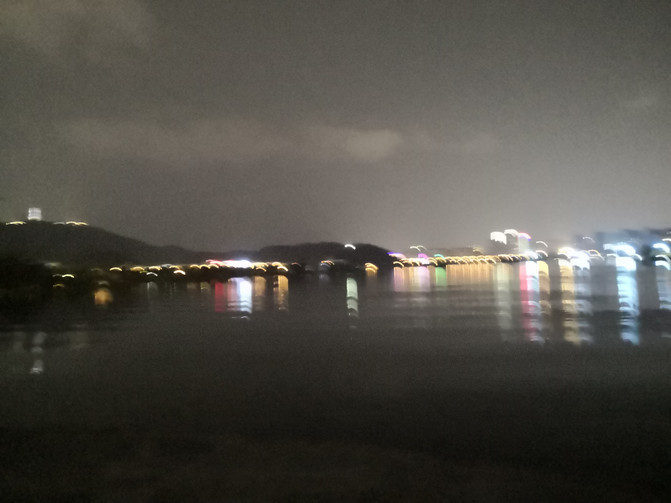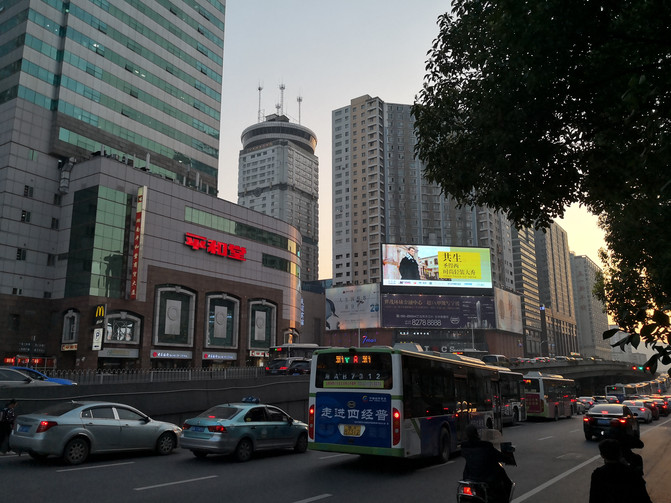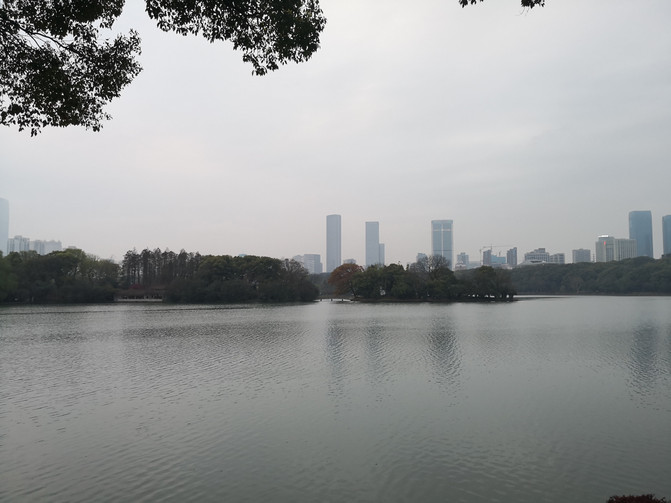The reversal of Spring Rain in Hunan 180--Changsha Imprints
Because of some work matters, I was able to come to Changsha several times, a city that is always rainy in winter and spring. As for the reversal of 180 in this name, it is because Changsha in my eyes has turned 180 degrees from beginning to end, with south to north and west to east. Only I know the discomfort.
To be precise, this article is not a travel note in the traditional sense, but an essay, just like I walked freely in Changsha. Therefore, we no longer follow the chronological order, but describe each place in Changsha City according to the outline.
The serial numbers are as follows:

1 Airport and first sight of Yulan Mountain Tea
It was still the first month, and the airport was filled with a festive atmosphere. The two-hour journey from Jinan Airport to Huanghua Airport was smooth. The pictures of Huanghua Airport found on the Internet have a very distinctive exterior design, but after leaving the airport, the lights are dimly lit and the rain is rustling, and the direction is reversed. I took the airport bus to the city and transferred to a taxi. The street traffic was crowded, so I checked into the hotel smoothly.




The propaganda words behind the cabin seats reminded me of Xizang and Tanggula Mountain Pass, a place at an altitude of 5100. The next travel story in Lhasa, the lack of oxygen in this place caused fainting on the Beijing-Tibet Railway.










When I woke up, it was the next morning. After the rain, the sky was as blue as washing. Walking downstairs and the roadside, I was amazed by the magnolias that were spreading the sky high on the roadside and the bloody camellia flowers low on the roadside. It was so beautiful that it was suffocating.











2 Xianjia Lake Meixi River Wangyue Park
Jinxing Road is west of Xiangjiang River. Looking from the overpass, there are many high-rise buildings on both sides. Connected to Xianjia Lake West Road. Searching the map, Xianjia Lake is nearby. It turns out that it is also called West Lake. In the evening, you follow the navigation along the road and slowly walk to the lake.





Through the overpass, you reach the Meixi River, and then Meixi Lake. The lights reflect on the vast water surface, which is very beautiful. Many citizens are exercising around the lake, and many adults are playing by the lake with their children. It is very lively.






Continue to cross the road and walk to Wangyue Park. It is even more lively here. There are many people dancing at the door, melodious dance music and constant laughter.




3 Museums
I had always heard that the Hunan Museum had cultural relics from the Han Tomb at Mawangdui, so I quickly found time to take a look. Very tall buildings, you can enter and visit for free with your ID card. Security inspection is strict, and items such as knives, eyebrows, knives and other items that do not conform can only be discarded. Opening hours are from 9:00 to 17:00 from Tuesday to Sunday (closed on Monday), so everyone must be careful not to miss the wrong time. The Western Han Dynasty's straight plain gauze clothes and the Western Han Dynasty's T-shaped silk paintings are all fine works in the collection. The Mawangdui Han tomb, the provincial Shang and Zhou bronzes, etc. are very amazing.


























There is a QR code next to the exhibits. After scanning, explanations are presented and voice explanations can be automatically played.

4 Orange Island
In the drizzling rain, go to Orange Island to play. There are small trains in the scenic area that carry tourists back and forth to various attractions. Line up to take the small train, get down at the head of Juzi Island, and see the huge statue of Chairman Mao. The Xiangjiang River is misty and rainy, which is very poetic.
















5 Yuelu Mountain
Yuelu Academy is famous. In Hunan University, it is not only Hunan University's talent training and research base for literature, history and philosophy, but also a tourist attraction in Hunan Province. It is also a cultural window and cultural business card for the entire Changsha City.
Yuelu Academy is one of the four famous academies in Chinese history. It is located at the foot of Yuelu Mountain on the west bank of the Xiangjiang River. As one of the oldest universities in the world, its ancient traditional academy buildings have been completely preserved today. Each group of courtyards, every stone tablet, every brick, and every wind lotus all shine with the humanistic spirit tempered by time. In 1988, the Yuelu Academy Building Complex was approved by the State Council as the third batch of national key cultural relics protection units. The Yuelu Academy has gone through thousands of years and has endless singing and learning. In the ninth year of Kaibao of the Northern Song Dynasty (976 AD), Zhu Dong, the prefect of Tanzhou, officially established Yuelu Academy based on the establishment of schools by monks and donated funds from the government. In the eighth year of Xiangfu of the Northern Song Dynasty (1015 AD), Emperor Zhenzong of Song Dynasty summoned Yuelu Mountain Changzhou Shi and awarded the four-character gate of "Yuelu Academy" with a royal pen. [1]Later, through the Southern Song, Yuan, Ming and Qing dynasties, to the 29th year of Guangxu in the late Qing Dynasty (AD 1903), Yuelu Academy and Hunan Provincial Capital University were merged and restructured into Hunan University, using the former site of the academy. In the 15th year of the Republic of China (1926 AD), Hunan University of Higher Education was officially named Hunan University, and the base of the college has still been expanded to this day. In 1986, Hunan University announced that it had completed the restoration of Yuelu Academy and officially opened it to the public. In 2005, Hunan University officially restored the Yuelu Academy, which has multiple departments including the Institute of Chinese Philosophy, the Institute of History, the Institute of Chinese Thought and Culture, the Chinese Academy Research Center and the China Soft Power Culture Research Center. In 2009, Yuelu College's disciplines ranged from undergraduate, master's, doctoral students to postdoctoral research mobile stations. It has officially become a physical educational institution and scientific research base of Hunan University. The thousand-year-old school has once again extended, and the thousand-year-old school has added glory.






































6 Qingshuitang
The exhibition hall of the former site of the Hunan District Committee of the Communist Party of China is located on Bayi Road. At this time, it was originally the northeastern suburb of the old Urban area, about 0.5 kilometers away from the city. At that time, there was a three-bay bungalow with a brick and wood structure. Because there were two ponds in front of the door, the water was bright and clear, so it was named Qingshui Pond. The house was once the secret residence of the Hunan District Committee of the Communist Party of China, but now a memorial hall has been built. The surrounding environment and interior furnishings have restored their original appearance. The memorial hall displays the main revolutionary deeds of the Hunan District Committee of the Communist Party of China and the cultural relics of the workers and peasants 'revolutionary movement under its leadership.
Tickets are free and you can enter with your ID card. The picture above is also shown at the entrance of the heavily guarded military region passing by.

























7 Kaifu Temple
It is said that Kaifu Temple is prosperous and its divination is very effective, so I went to have a look. Passing through the dilapidated Dongyue Palace and the former granary. Kaifu Temple is located in the Xinhe River in the north of Changsha City, facing the Xiangjiang River. The main building faces north and south. It is a temple of the Yang Qi School of the Rinji Sect of the Zen Buddhism.
Kaifu Temple was built during the Five Dynasties and later went through the Song, Yuan, Ming and Qing dynasties. Covering an area of 48,000 square meters and a building area of 16,000 square meters, there are three Buddhist halls, namely, the Three Sacred Hall (Maitreya Hall), the Great Buddha Hall (Daxiong Hall) and the Pilu Hall. There are guest halls, fasting halls, warehouses, and abbot rooms in the east wing, and Shuyan halls, Zen halls, etc. in the west wing. In the temple, there is a stone tablet during the Kangxi and Guangxu periods of the Qing Dynasty
Kaifu Temple is one of the key open Buddhist monasteries in China and is listed as a key cultural relic protection unit at the provincial level in Hunan. The Hunan Province Buddhist Association and the Changsha City Buddhist Association are both located in the temple.


















8 May Day Business District
I heard that the May Day Business District is the most fashionable and prosperous place, with a lot of lively snacks, so I strolled over from May Day Road to have a look. Unfortunately, Wuyi Square and Furong Square are both very small. I saw fresh strawberries and water chestnuts on the roadside. Strawberries were more than 20 kilograms and water chestnuts were not expensive.






















9 Furong Middle Road and Zhongnan Xiangya
Furong Middle Road is one of the main roads that runs through Star City. The road is wide, and the street trees are mostly tall camphor trees. The greening has camellia trees. The flowers are gorgeous and huge. The entire bud falls under the tree, which is very chastity and shocking. Heartbreaking.










The orange building on the west side of Furong Middle Road is Xiangya Hospital. Thinking of a saying before Maoism, Southern Union and Northern Xiangya, Xiangya, as a century-old school, can be called a leader in the medical field. Xiangya now belongs to Central South University. Walking around Xiangya Hospital, I saw the old buildings and Chairman Mao's inscriptions. They were antique and accumulated culture and history, giving me a unique taste.

















10 Martyrs Park
Martyrs Park is a quiet and elegant place in the bustling urban area of Changsha. From Yingbin Road on the south side of Dongfeng Road in the west, you can feel the clean atmosphere.


There are many bus stops at the south gate of Martyrs Park, which is the starting point for many buses. Yingpan East Road is a very special place at the underground passage under Nianjia Lake.













The environment behind the Martyrs Memorial Tower is more tranquil, with flowers and ancient trees towering into the sky.



There are crowded people here. Is it a blind date corner? Walking in, it sure is.


On the east side of the park is the sparkling Nianjia Lake. It is easy to think of the word carnival and it is very distinctive. There are complete dining and entertainment facilities around the lake, and children and adults laugh constantly. It seems to be a very popular place.















11 Bus and train stations
For a traveler, the most direct impression of a city's transportation is the railway station. The design plan of Changsha Railway Station is very impressive. This is the information I saw on the Internet.design schemeThe main structure of Changsha Station's design plan is "square box + bell tower + torch". The square box refers to the main building below, the bell tower is to make it easier for everyone to travel on time, and the torch is to reflect Changsha elements. Changsha Station is a Tian-shaped plane with staggered levels in front and back and tunnels entering the station; the Bell Tower Torch with a national style symbolizes that Changsha was the first place where Chairman Mao lit the revolutionary fire. The station's torch burning plan was finally decided by Minister Wan Li: there was no wind, and the torch flames burned into the sky, reflecting "calm and calm, and the country was peaceful and the people were safe."

Construction situation On July 1, 1977, the 56th anniversary of the birth of the Communist Party of China, Changsha Station was officially completed and opened to traffic amid celebrations. Different from the North Railway and Freight Station at that time, people called it Changsha East Railway Station. It was a first-class passenger station on the Beijing-Guangzhou line. It had 10 workshops, 12 stock rooms, and 898 employees. According to the commander's speech at the opening ceremony of Changsha Station in 1977, more than 400,000 people from all over Changsha City participated in voluntary labor to build the station, and various vehicle-owned units supported the station in transporting more than 300,000 tons of materials and materials. In 2009, Changsha Station won the "Architectural Creation Award for the 60th Anniversary of the Founding of the People's Republic of China". In 2013, the clock tower clock at Changsha Station underwent the largest maintenance since its completion. While keeping the appearance of the clock face unchanged, a number of the latest domestic technologies in China were used. The control system uses a GPS satellite positioning system to automatically calibrate the time to ensure that there are very few errors.


At night, Changsha Station shines brightly.

There are many bus lines in the city, and the Hunan Travel Card has been downloaded, making travel very convenient.











12 snacks
There are many snacks in Changsha, including rice noodles. There are all kinds of rice mixed with many chili seasonings. On the first night, I loved to eat spicy food so spicy that my stomach was churning, and the next day I recovered after not eating for a whole day. I want to eat steamed buns, noodles, dumplings, but it's difficult. There are no places, or I can't find them.























13 The vernal equinox of rainy weather
The above places are all very small places in Changsha. For the entire Hunan tourist map, they are just the locations I circled. It seems that if you want to fully understand Hunan, the task is still arduous.

In the past few days in Changsha, Hunan, it happened to be the vernal equinox. Such a beautiful picture is very appropriate to the beauty of Changsha.

Finally, post a screenshot of the weather in Changsha in recent days.


Not long ago, I heard that he frequently recruited talents and lamented his broad thinking and foresight! Recently, I learned that Changsha has been promoted to a first-tier city in China. Congratulations!! Here, as the conclusion of this travel note, it is also a icing on the cake. Blessing Changsha!!!
Previous Article:Changsha, a happy city!
